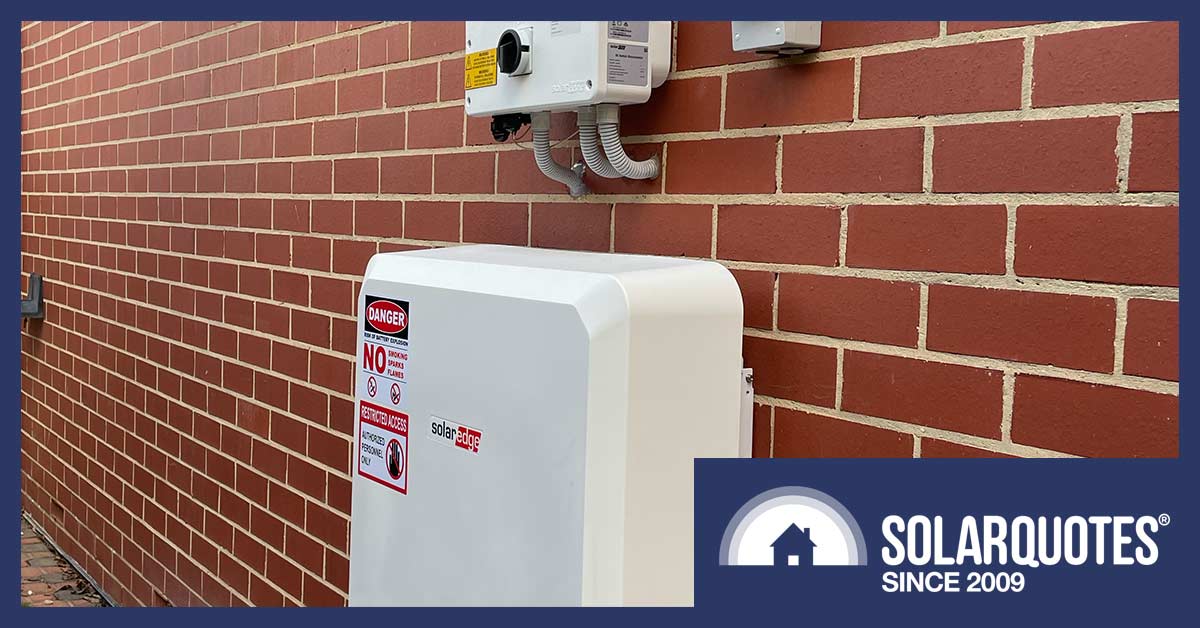
The Australian Standard for home battery installations is quite strict about where solar batteries can and can’t go.
The best place to install a home battery or two is usually in a cool garage1, behind bollards where necessary.
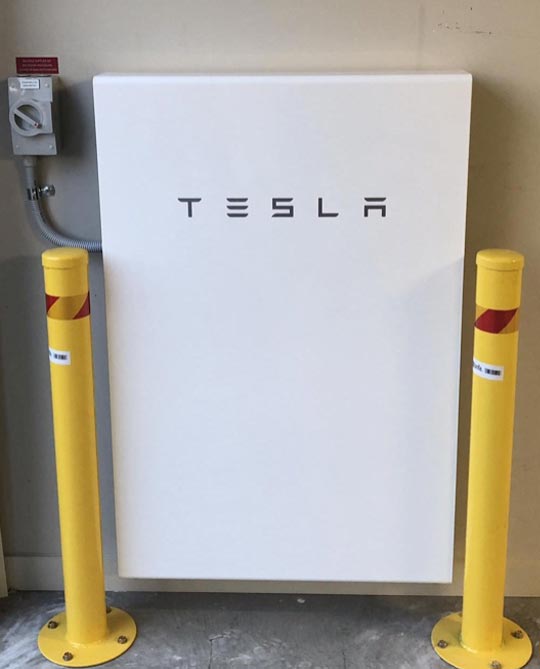
Installation: Goliath Solar & Electrical
But where else can batteries go?
To be honest, that is a question that plagues a lot of installers. Around the side of the house might seem ideal, near the switchboard, but often it’s not – particularly if that puts your battery in the hot afternoon sun.
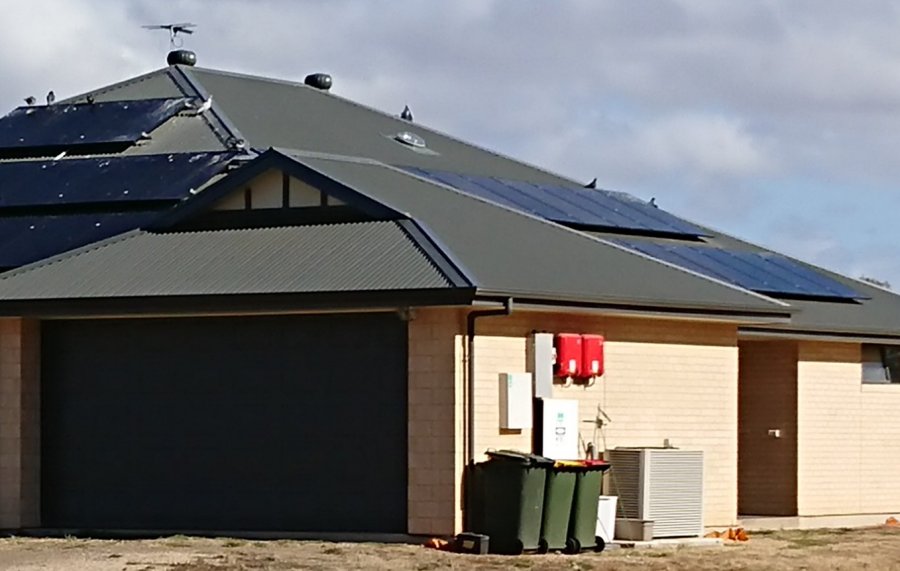
In the blazing afternoon sun, right next to the hot breeze coming from the air conditioning unit, is such a hellish place it probably voids the warranty.
Back in the days when lithium-ion home batteries were brand new, and the Tesla Powerwall still had some curves like a plump toddler, the electrical industry waited with trepidation for Australian Standard AS51392, which would mandate where home batteries could be installed.
Rumour had it that the standard would force all new batteries inside a proverbial brick shithouse. But thankfully, the idea of a freestanding fireproof kiosk wasn’t mandated. It would have made things very expensive and electrical connections very difficult.
The new rules have been out for a while now, and the industry has had time to interpret them, so I’ll outline the main points to consider so your home battery location complies.
I’m Talking About Lithium-Ion Batteries
The standards were originally created to ensure lead-acid batteries did not accumulate explosive hydrogen gas in a building. Lead-acid energy storage is still in use, primarily to power off-grid homes. But their only advantage – a lower upfront cost – is gone now. Vale lead-acid. The scrap man will miss you.
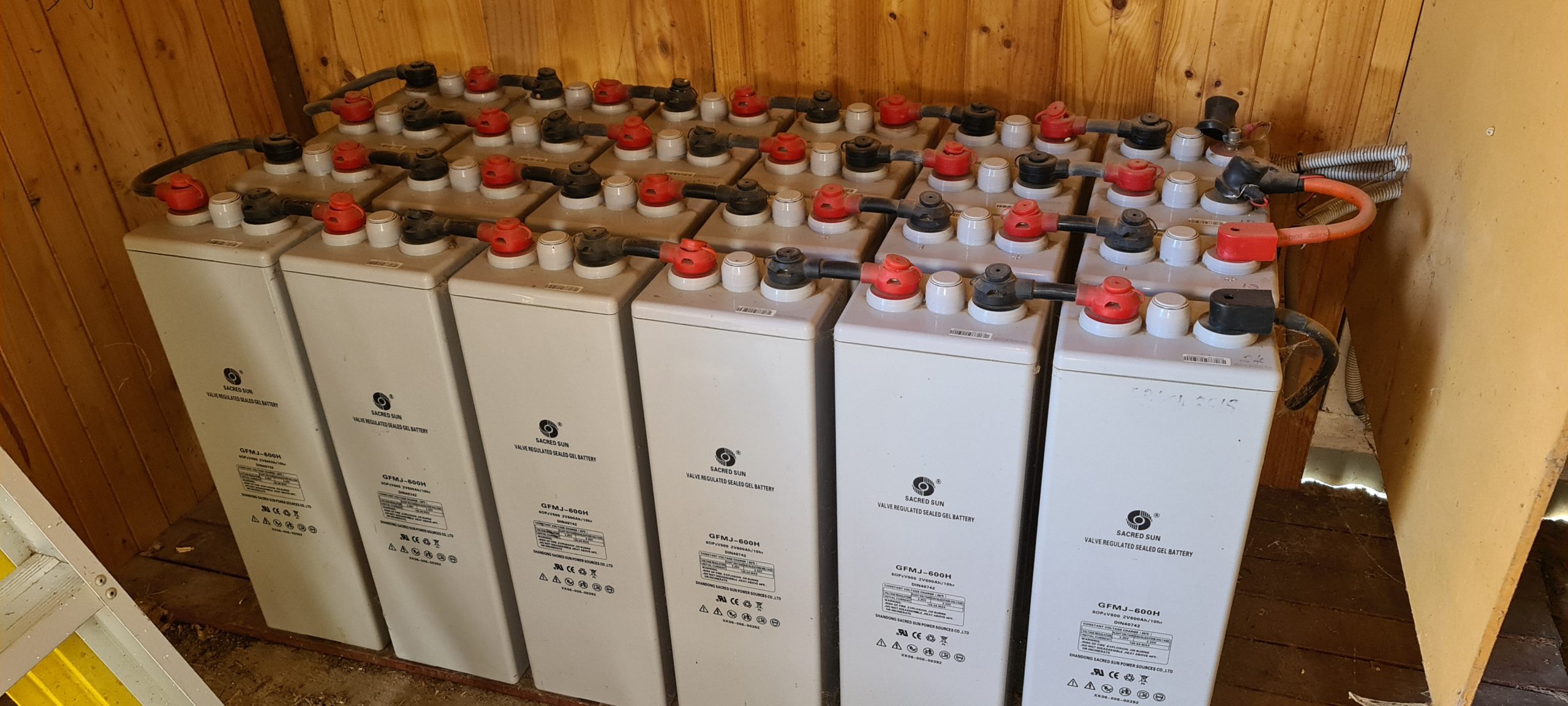
This is what a ton of lead looks like as nominal 2-volt cells in series.
These days, it’s (almost) all about lithium chemistry batteries. They’re smaller, lighter and have far better electrical performance. It seems the only downside is we are still working out how to recycle them as well as we do lead-acid, and lithium-ion is just a bit more spectacular in the unlikely event of thermal runaway.
Forbidden Home Battery Locations
There are lots of places your battery cannot go. To cite the rules almost verbatim, restricted locations include:
- within 600mm of any exit
- within 600mm of any vertical side of a window, or any building ventilation, opening into a habitable room
- within 600mm of any appliance
- within 900mm below any opening into a habitable room, vent or appliance
- in ceiling spaces
- in wall cavities
- on roofs (except where specifically deemed suitable)
- under stairways (with or without naughty children)
- under access walkways
- in an evacuation route or escape route.
- blocking access to a switchboard (see AS 3000)
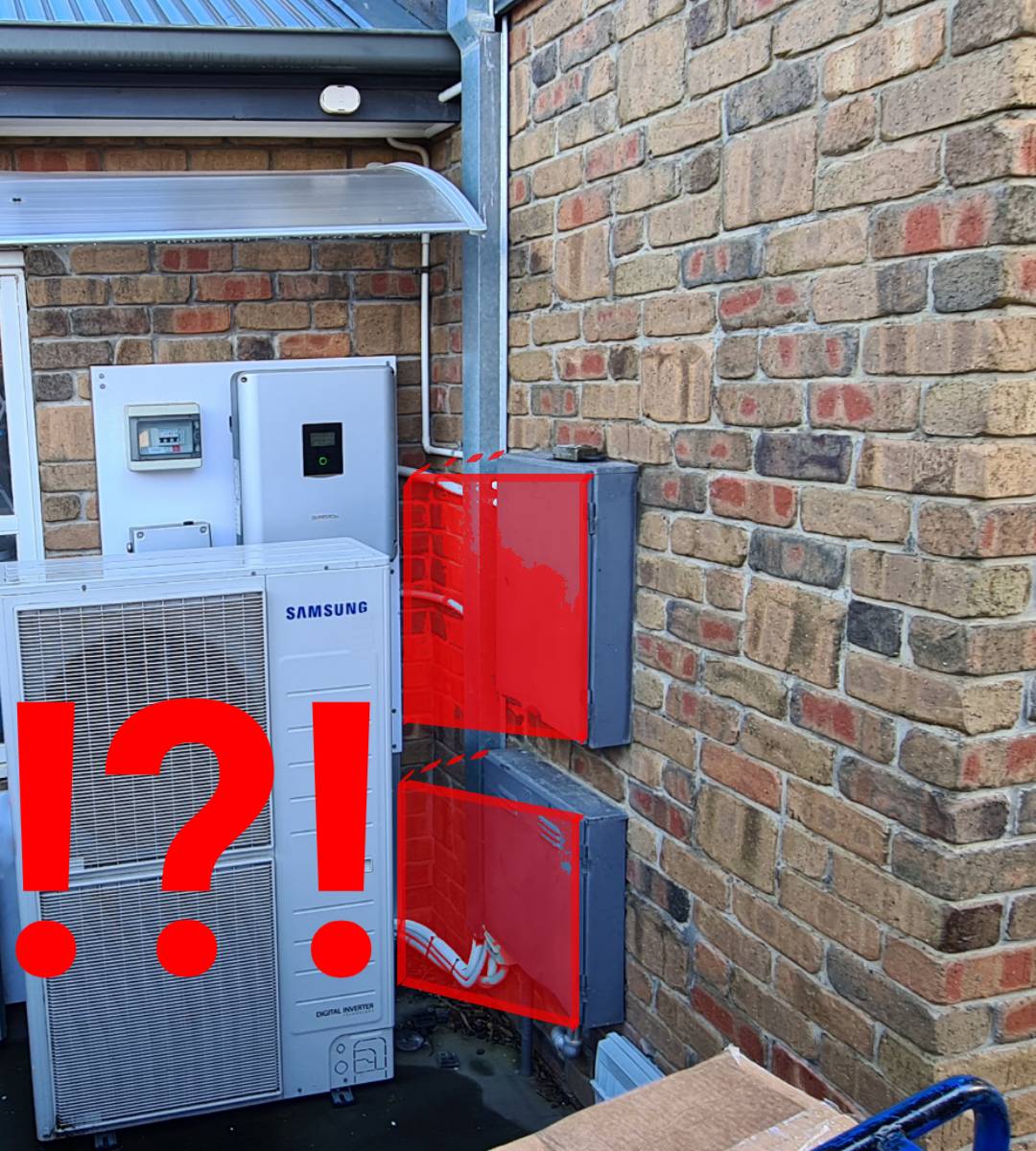
You can’t access the switchboard when the ‘fridge mechanics put an air-conditioner unit in front of it. Just how do we get to the inverter or even open these meter boxes?
Garage Doors: A Silly Rule
Below is a classic example of standards gone a little batty. The rule states that a battery shall not be installed within 600mm of any exit to a building envelope, including garage doors.
So while you can’t put a battery next to a personal access door that’s 0.75 metres wide, the same rule applies to a double garage door… at 5.4 metres wide. I think we can all make our minds up about that one.
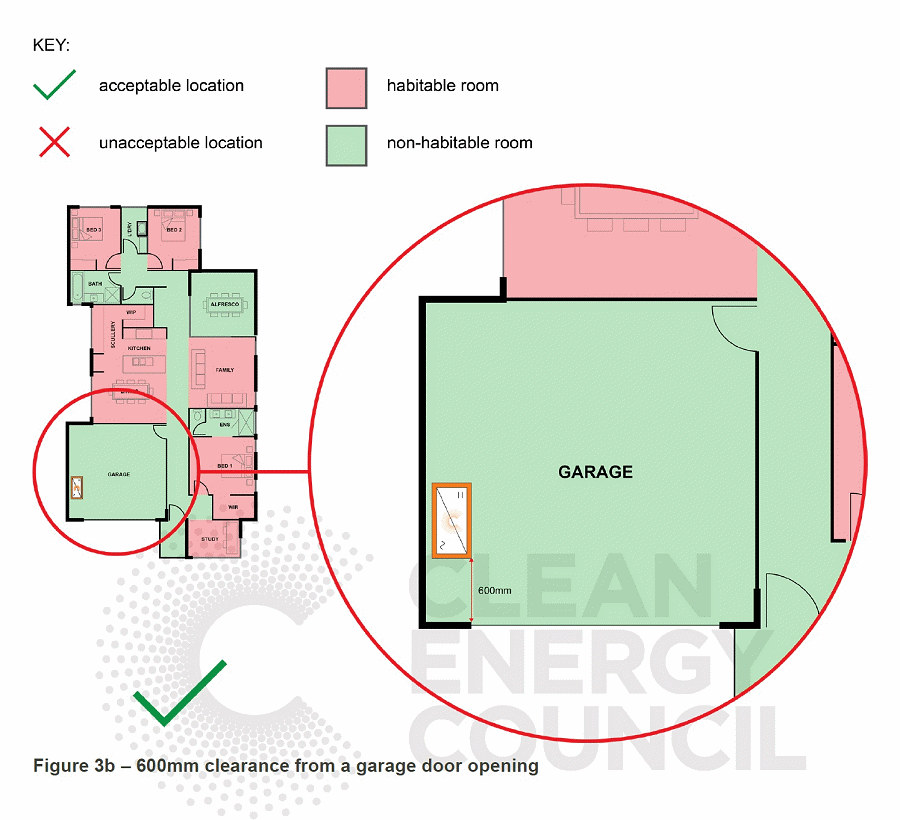
Somebody at the CEC has a sense of humour – they specifically enlarged the most ridiculous part (while also putting the “alfresco” inside the building). Interestingly, the requirement to have protection that stops you crashing your car into the battery seems to have escaped this drawing. The industry go-to is a yellow bollard bolted to the garage floor.
Fire-Rated Barriers & Habitable Rooms
Because some people don’t even know when their arse is on fire, the standards dictate your battery must be on a fire-rated surface – but only if there is a habitable room behind the wall.
Cement sheet weatherboards, plastic joining strips, vents, and expansion joints in brick walls often mean your wall isn’t deemed a fire-rated barrier. 300mm of space away from the wall can solve these problems entirely.
Note: A common misinterpretation of AS5139 is all batteries must be installed on a fire-rated barrier, regardless of the proximity of habitable rooms. This is not correct.
Associated Equipment Can Be in The Battery Exclusion Zone
As you can see, the exclusion zone is pretty big.
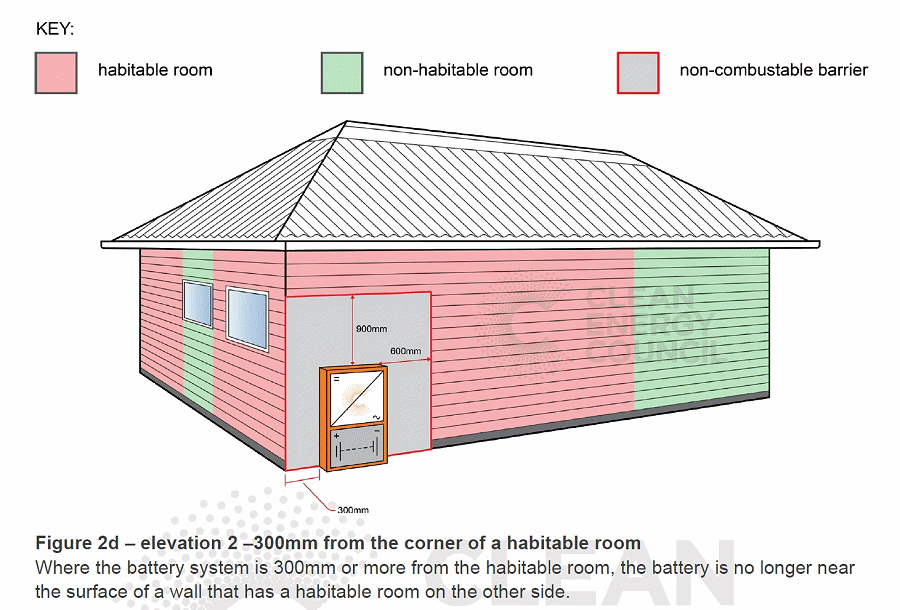
Image Credit: CEC – as if you don’t already know, thanks to the GIANT WATERMARKS
This is a large area to exclude any other appliances from. Luckily, ‘associated equipment’ such as a solar inverter can be inside this zone.
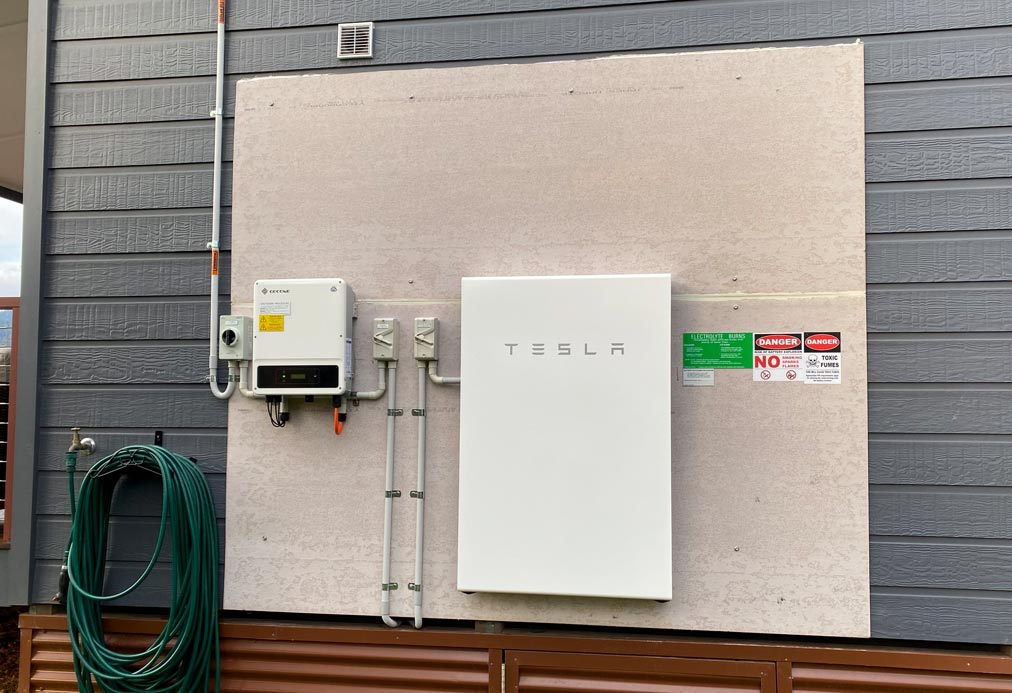
Installation: Lightning Solar & Electrical Melbourne
Battery Form Factors
Some batteries are just a big single lump, like a SolarEdge Home Battery. Others are a bloody huge lump, like the 236 kg Z-Cell flow battery. I can tell you first-hand that when one of those behemoths is expected to go on a 1.2 m high shelf inside a cupboard on the tiled verandah of a heritage house, ‘difficult’ is putting it politely.
Modular Batteries
Other batteries come in neat little blocks that nest together (Sungrow and BYD should be applauded here):
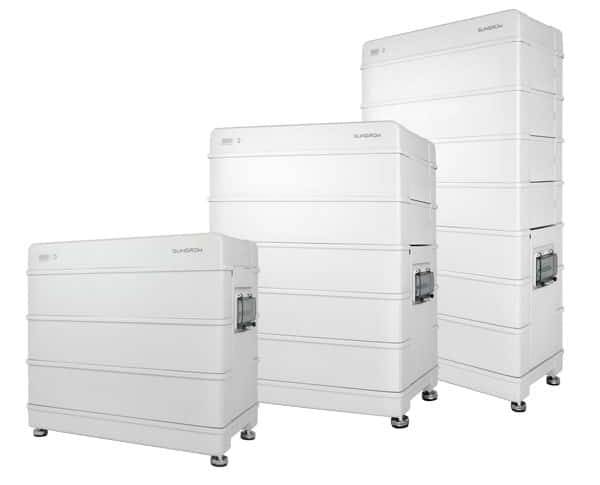
Sungrow make good modular batteries.
Rack Mount Batteries
Others come in slabs that fit into a standard computer server rack (Pylontech and Australian-made PowerPlus for example):
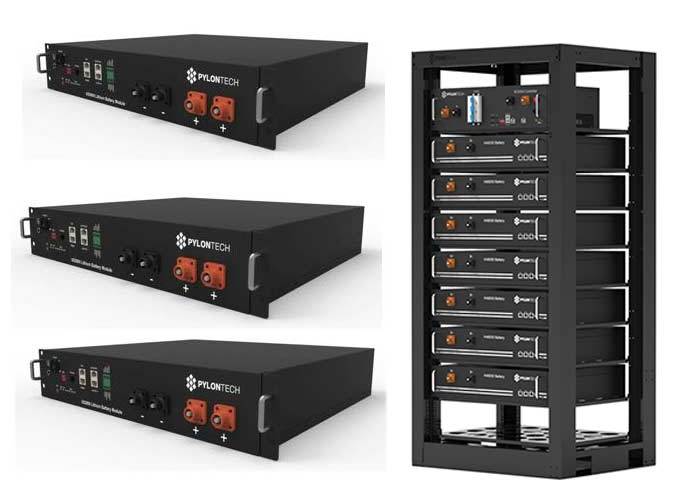
Pylontech batteries can be rack-mounted.
These are pretty easy to handle and allow you to grow capacity incrementally with your use or budget. But if you wait over a year to expand, you risk the battery model becoming obsolete, so be careful.
All-In-One Batteries
All-in-one batteries have the battery inverter or hybrid inverter in the same box as the battery. They hook up like any hard-wired appliance, so there can be some simplification in the wiring.
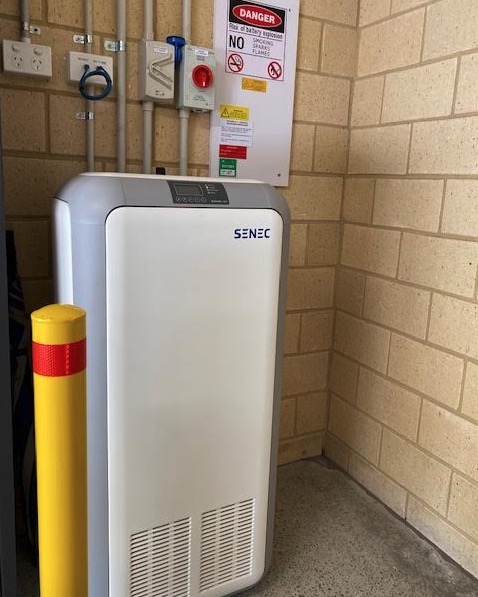
All-in-one batteries can simplify wiring. Senec installed by JCW Electrical
Connections
Where your battery goes will affect the length of cable runs for power and communications. Long and difficult cable runs can significantly add to the difficulty and cost of the battery installation.
Power
If your battery is DC-coupled, it must be pretty well adjacent to the inverter controlling it.
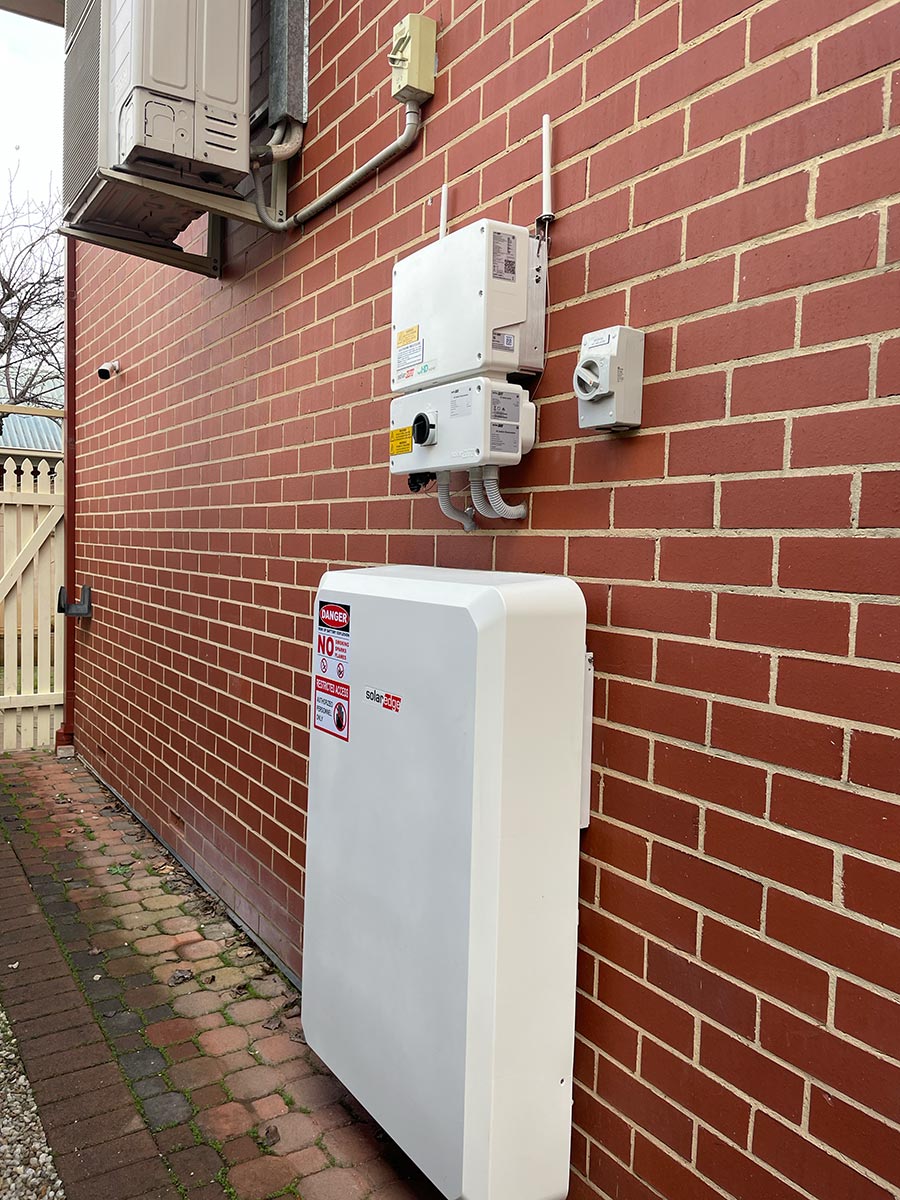
This DC-coupled battery is right next to its hybrid inverter. Installation: SEM Group
If your battery is AC-coupled, you have more flexibility with location. The inverter can be some distance away. This is good news if you have microinverters, which are obviously, on the roof.
Communications
Many batteries or their accompanying inverter need a solid internet connection for commissioning, monitoring, warranty and/or network approval or control.
A wired internet connection is best because it is immune to Wi-Fi password changes and weak wireless signals.
All of these battery systems also need a consumption meter to monitor comings and goings from the grid. This communication link usually needs to get to your switchboard. Some consumption monitors offer a wireless link, but again, wired is more robust and preferred by every installer I’ve ever met.
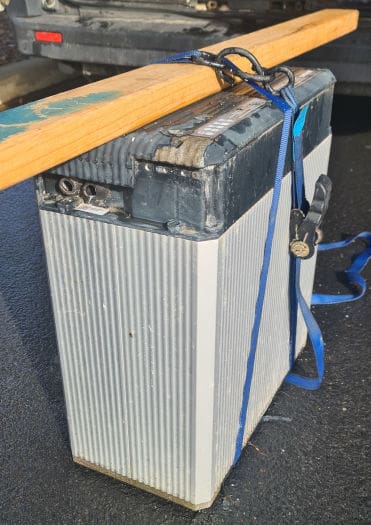
This LG was left out in the weather and is a disgusting mess considering how much it cost.
The Ideal Location
When choosing where your battery will go, it must:
- comply with AS5139
- be next to the battery or hybrid inverter if it is a DC-coupled battery
- be out of the direct sun
- and ideally, be easy to get the power and communication wiring to it.
If you are retrofitting a battery, your list of possible locations is probably very short.
If you are installing ‘battery-ready’ solar, consider where it will go and place your inverter accordingly.
If you are building a home from scratch, make sure you’ve got a compliant spot in mind for the battery, and talk to a good installer about what pre-wiring you can do for comms and power.
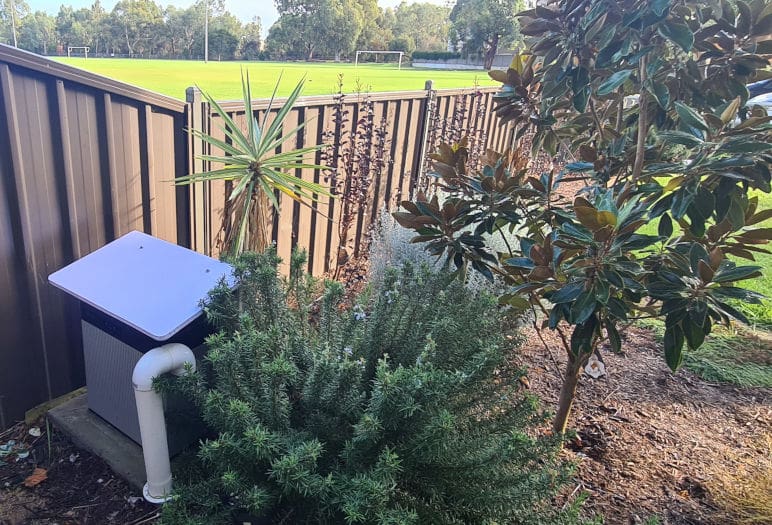
This is about as bucolic as a battery location gets but I’d still prefer to see a little better weather protection than a lid and a backboard with a drain pipe riser for cables.
Footnotes
- In your new electric car to be more precise, but that’s a discussion for an entirely different post. ↩
- AS/NZS 5139:2019 “Electrical installations – Safety of battery systems for use with power conversion equipment.” A bargain at only $280.62 for an un-shareable, non-portable, print-once if you are lucky, DRM’d to the eyeballs protected PDF. ↩

 RSS - Posts
RSS - Posts



While it was my intention to augment an off-grid domestic battery with V2H from an EV, when the prices drop a bit, the deleterious effect on battery life is a significant disincentive, I figure. The ternary lithium EV batteries don’t have the cycle life, so I’d wait for an EV with a well warrantied LiFePO4 battery before considering V2H. Until then, the petrol generator remains essential.
It would be interesting to see some figures on VPP returns and self consumption vs clobbered EV battery life at current battery replacement costs.
My understanding is that similar batteries to the Pylon Tech battery as per photo above can be mounted vertically, however the case to fit them into in some instances costs nearly as much as the battery. The Battery and Solar electronics to be under a veranda against a brick wall.
Can a Metal ( or Fibre Glass) cover (legally) be fabricated to fit on the top of said vertically mounted battery that is off the ground by 50mm x 50mm blocks of wood and off the brick wall by 50mmx 50mm blocks of wood and horizontally strapped to the wall with thief proof nuts. The cover also connected/bolted to the horizontal straps.
Peter
I’m guessing most batteries will make the shift to LFP.
Cheaper, safer, more cycles … but a bit heavier and more bulky (who cares!)
A matter slightly aside from the comments above which I am concerned about.
I am located in Western Australia and I have been advised that the fire brigade will not tackle a household fire in which solar batteries are involved, they also will not tackle an electric motor vehicle fire. This information was posted on the mobile phone data. I am about to chase this further with the WA fire brigade however in just reading your article I write to seek your advice.
I have a Growatt system with battery backup which I believe fits the specifications provided in this article but am concerned.
Any advice would be most appreciated
Getting info. is always important. Another piece of information to remember is that about 99.995% of electrical fires are due to grid-supplied/regulation-controlled MAINS power. And most of the remaining housefires are due to letting the kids play with matches. IS THERE actually a recorded case of a house burning down due to a solar-system? And if there IS, I’ll lay money it was due to an incompetent/stupid installer. Any takers??
I was all set to order a battery system 18 months ago when I learned that I had to put bollards in despite the fact that it is virtually impossible to accidentally drive my car into the wall-mounted battery.
I don’t want to add unnecessary penetrations through my garage slab nor do I want to look at industrial yellow posts in my house. Do the specs require bollards to be ugly or can I use stainless steel or some other material that isn’t as visually intrusive?
Does the standard allow one to demonstrate equivalent safety without strict compliance with the distance or bollard specs? For example, can the battery be mounted on the wall above any possible vehicle impact in order to avoid bollards? Or could it be mounted behind a work bench, i.e. the bench serves the function of a bollard in preventing inadvertent vehicle impact?
Would an exterior placement an a west-facing wall with some shading added to intercept direct sun be compliant?
Hi Brad.
Battery installers are required to assess the risks associated with a battery installation and take actions to mitigate or remove them. This includes protecting batteries from mechanical impact from a vehicle. But, as far as I am aware, there is no requirement for yellow bollards. As long as the barrier is effective its appearance is not an issue. That said, I recommend having a barrier that is clearly visible to stop people accidentally hitting it.
The SolarEdge DC Coupled battery (SolarEdge Home Battery) can actually be installed up to 50m away from the inverter..!!
This is due to the fact that the battery is DC coupled to the Optimised PV array which as part of the SolarEdge intelligent DC management can be fully managed and controlled, unlike other DC coupled systems where the DC power is subject to all of the functions and loses that you would normally expect.
I live in a unit, with only a tiny (less than 1m deep) lockable shed next to the carport. I take it that the rules assume no batteries in livable spaces themselves, so even if installing one was viable (the roof only had room for about 6 kW of panels) I don’t think that, short of having a brick cubby built for it in my back yard, I’d have anywhere to put one.
I have a 12 volt off grid system that is about to be replaced. I am suggesting the batteries sit on a concrete slab under the house (which I have constructed) with a wooden floor 1.3 metres above the slab. Less than two metres above the front of the batteries the charge controller and inverter and battery charger will be attached to a cement sheet barrier on the outside of the house wall with a two metre wide south facing veranda protecting them from wet weather and sun exposure. There is a small window one metre above this infrastructure leading to a loungeroom with a high ceiling. Do I need to remove this window and wall it up? and are the batteries alright in that location? Lastly if I choose to change to a 48 volt system, as many are suggesting, can all the components sit in the same locations?
I don’t have much usable wall space to install a battery, however I have a pretty good standalone open space next to the house next to the meter box which is effectively ‘dead’ space.
For a floor stacked battery such as the Sungrow, is there anything stopping me from pouring a slab, digging a small trench to the house for cabling and having the battery installed on that?
On face value it seems safer to have a bit of separation from my timber clad house anyway.
Great idea Dan, something I’ve seen done a few times.
(Only thing is protecting it from the weather)
Thanks for the reply Anthony.
In terms of protecting it from the weather, do you mean direct sunlight? Or in general (e.g. rain etc).
The place I have in mind is decently shaded and would only get morning sun.
I suppose I could get it covered somehow as well. My potential installer had a site inspection today but wasn’t sure on if it would be possible to install away from a wall and will come back to me.
Will update on how this ends up for the next person looking to do something similar.
Hi Dan,
It’s quite doable, up to 10 metres for Sungrow and 50metres(!?) for SolarEdge IIRC.
I would get a little garden shed/cupboard, but insulate it with EPS foam (broccoli box) and put some big holes in for vents.
I’ve just updated the blog article with a couple of garden photos just for you 😉
Hi
A question re solar battery location arose today.
Can we install in a garage which has a bedroom on the level above the garage ?
Is this classed as “under a habitable floor”
We have the 900 clearance above etc in the garage .
Regs seem a bit vague for a double storey property.
Hoping for a reply cheers
Hi Paul,
I appreciate your frustration. 900 clearance above is about where the obligations stop, but it’s really down to the installer who looks at the property in question and signs off on the end product.
Hi
Thanks for taking the time to respond.
We however should not have to run the risk of an unsatisfactory install if the regs we are working to are full of grey areas to be interpreted as we like!
I’m sure auditors have their own ideas too and that may be different to our interpretation.
Still none the wiser but this issue with the rise of townhouses is going to be a common decision.
Cheers 👍
It seems doubtful that EU-style obsessive proscription would in reality be preferable. Those of us capable of dealing with life like some freedom of action. Just as we choose whether to engage in skydiving or rockclimbing,
it doesn’t seem too hard to make an individual risk assessment.
Mine would be:
o Don’t charge Li-Ion indoors, just in case. LiFePO₄ is statistically safer.
(Both my house & EV batteries are LiFePO₄. The BMS limits voltage, current, and shuts down on overtemperature. It balances cell voltages.)
o If the overhead floor is not a fire rated steel reinforced concrete slab,
then put a firewall under it, e.g. two thicknesses of fire rated plasterboard,
with any holes of wires or pipes sealed with fire rated tumescent goop.
o Insure well. (My on-site solar installer offered that one, this afternoon.)
o A fire alarm is preferred to a smoke alarm, in some guidelines, for the garage, especially if welding might be done there. It needs to be wired to those on the floor above.
If built to current guidelines, there should already be a fire barrier between Class 1 and Class 10, habitable area vs garage. (Mine, between habitable and workshops goes up through the roof space, and seals to the roof. For an overhead ceiling/floor to hold, the supporting walls should also be done, I’d suggest.)
I’m only a two-time owner-builder, so this is anecdotal experience, not professional advice.
Looking at retrofitting battery storage in my home that already has a PV system.
What’s the go with water pipe, gas pipe (not appliance) and electric wires in metal conduit running on the wall where a battery is to be installed?
Where the battery’s inverter sits on top of the battery, does the required clearance above include the inverter?
Hi Dave,
An inverter is “associated equipment” so it’s allowed to be inside the zone for the battery itself.
I think anything in a steel conduit is safe however your installer it the one examining the site and signing off on the package so it’s up to them to make a final decision.
These guidelines do not recognise required clearance of 1.5m around gas bottles. Many residences have them on outside walls. This has caused a problem.
0414719487
The clearance from gas bottles is covered in clause 4.18.2 of AS/NZS 3000 which covers all electrical work. That’s why it doesn’t need to be in the battery standard.
I’m looking at 25kw of Ginko panels match to a Sungrow Inventer & battery stack….with the batteries located about 40m in cable length at the rear property boundary.
I’ve been told that even though the batteries are not IP66 compliant that a small shade over them will be sufficient – note location is protected on two sides and in shade most of the day.
Hi Stuart,
Keeping them out of the weather is always a good idea. I would ask about the overall length of your AC run though, especially if you have backup circuits running through the inverter.
see attached articles :
https://www.solarquotes.com.au/blog/solar-voltage-rise-drop/
https://www.solarquotes.com.au/blog/shed-solar-distance/
(Some systems will allow the battery to be separated from the inverter, but I’m not sure that Sungrow will tolerate 40m? Cable would still need to be large but only a single run at least)